Are you wondering how to create a driver reward program? How to motivate your fleet drivers?
Recognition matters more than ever: 35% of employees feel that receiving more recognition from their organizations would be a key way to better support them.
Let’s explore budget-friendly ideas to craft a successful driver incentive program (and driver incentive program examples) that not only acknowledges your team’s efforts but also keeps them enthusiastic about their roles.
And if you’re looking to enhance your fleet operations further, we offer fleet management software development services tailored to your specific needs. You can always reach out to us via info@volpis.com to schedule a free consultation.
How to create a driver reward program: 8 most common driver incentive ideas
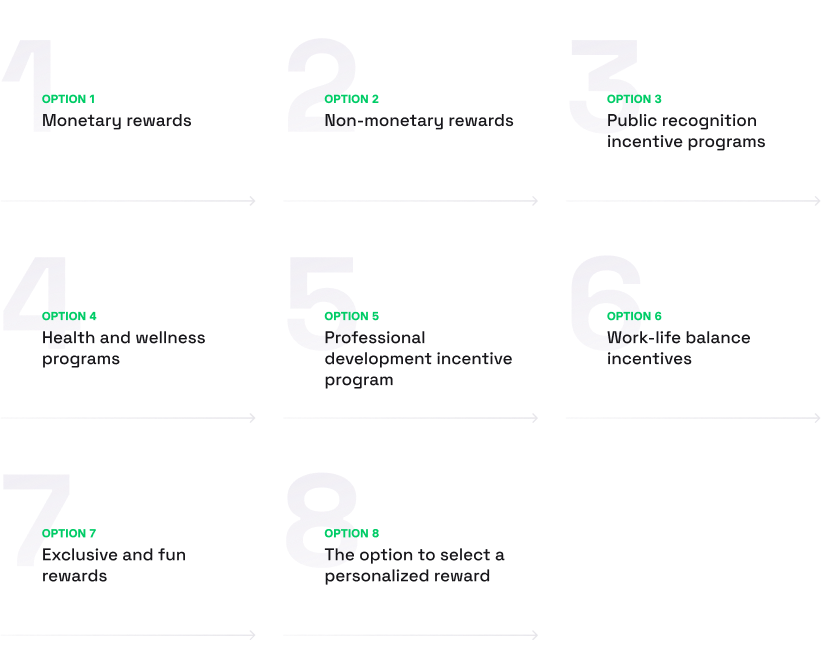
A Payscale study has highlighted a crucial insight: 65% of U.S. employees prefer bonuses that reflect their individual performance. This finding is a key consideration when designing an effective driver incentive program.
With this in mind, let’s dive into the most common truck driver incentive programs that strike the right balance between rewarding individual achievements and fostering a positive team environment.
1. Monetary rewards
When it comes to rewarding your driving team, nothing speaks louder than monetary rewards. Here’s how you can make your team’s payday extra special:
- Cash bonuses: Direct financial benefits to the employee.
- Salary raises: Longer-term financial benefits.
- Gift cards: Prepaid vouchers that can be used at local restaurants or other businesses.
- Referral bonuses: Rewards for bringing in new talent.
- Profit sharing: Distributing a portion of profits to employees.
- Bonus checks: Extra paychecks as a form of appreciation.
2. Non-monetary rewards
Moving beyond the monetary, let’s talk about driver reward programs that touch the heart rather than the wallet. Non-monetary rewards are all about those thoughtful actions that say ‘we see you and appreciate you’ in a personalized way:
- Extra time off: Additional vacation days or leave.
- Equipment upgrades: Enhancements to work tools or vehicles.
- Special privileges: Flexible work hours and remote/hybrid work options.
- Awards for spouses of truck drivers: Recognizing the support of truck drivers’ spouses.
3. Public recognition incentive programs
Public recognition is all about celebrating achievements and making sure everyone knows about the stellar performance of your drivers:
- Formal recognition: Certificates, letters of recognition, plaques, and trophies.
- Informal recognition: Thank-you notes and shout-outs.
- Social recognition driver incentive program: Recognition within the community or social platforms.
- Points-based recognition incentive program: Earning reward points for truck drivers.
4. Health and wellness programs
These truck driver incentive programs are designed to show your team that their health and happiness are just as important as their professional achievements:
- Health and wellness reimbursements: Covering health-related expenses.
- Travel incentives: Paid trips for achieving specific goals.
- Club memberships: Access to health clubs or similar facilities.
5. Professional development incentive program
Investing in your drivers’ skills and knowledge not only benefits them personally but also drives forward the success of your entire fleet. Professional development is a reward that keeps on giving:
- Professional development opportunities: Training and career growth initiatives.
- Tuition reimbursement: Covering educational expenses for further learning.
6. Work-life balance incentives
Incentives that help your drivers juggle the demands of work with their personal lives show that you value their time both in and out of the driver’s seat:
- Special privileges: flexible work hours
- Childcare subsidies: Financial support for childcare.
- Paid time off: Offering paid leave beyond standard vacation days.
7. Exclusive and fun rewards
Rewards that bring a sense of excitement showcase that appreciation can also be about creating memorable experiences:
- VIP experiences: Event tickets.
- Team-building activities: Unique, memorable experiences.
- Company swag: Branded merchandise.
- Electronics and home goods: Tangible gifts that cater to personal interests.
8. The option to select a personalized reward
Last but not least, the power of choice. Allowing drivers to select their own rewards acknowledges their unique preferences:
- Tailored options: Offer a range of rewards to cater to different tastes and needs.
- Diverse selection: Include options like experiences, products, or services.
- Feedback-informed: Regularly update the choices based on employee feedback.
Setting up a driver rewards program: step-by-step process
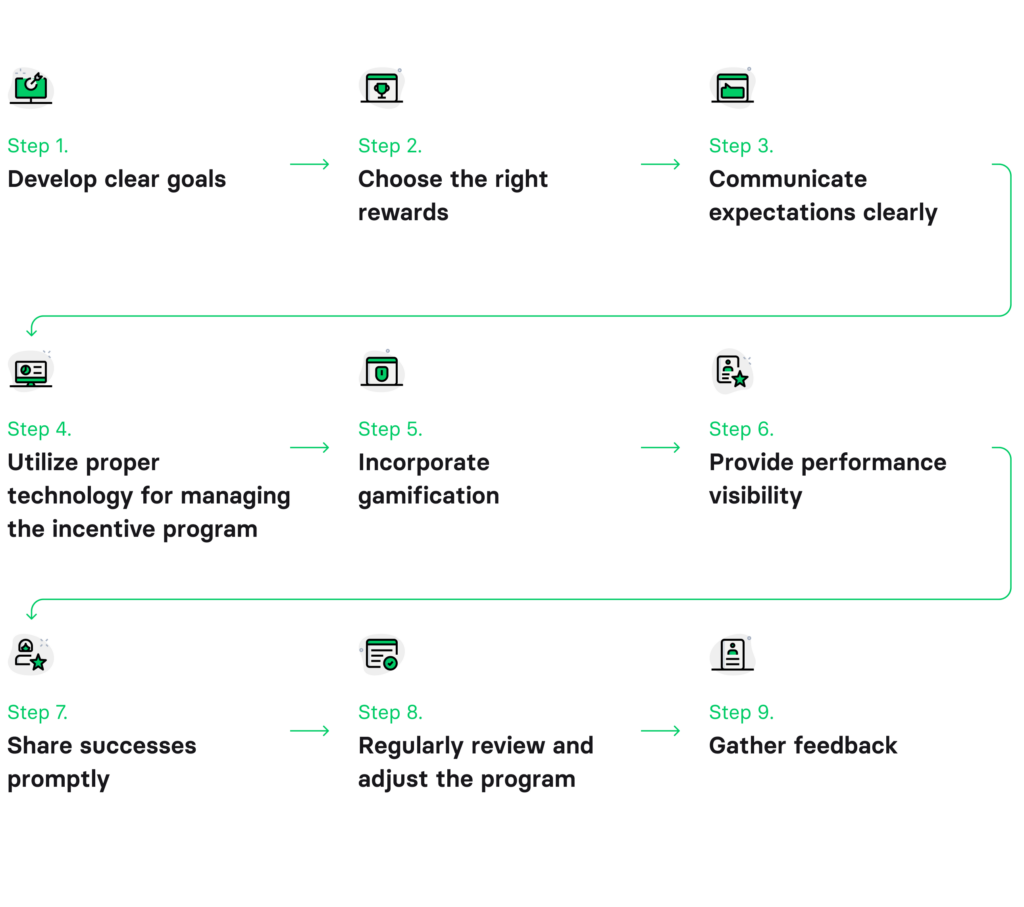
How to incentivize truck drivers? Let’s dive into how you can effectively implement a successful driver incentive program that makes a real difference in your team’s performance.
Step 1: Develop clear goals
Start by defining what you want to achieve. Are you aiming for improved safety, enhanced productivity, or better customer service? Setting specific, measurable goals will guide the structure of your incentive program.
Step 2: Choose the right rewards
Based on your goals and your team’s preferences, select rewards that will resonate most with your drivers. Consider a mix of monetary, recognition, and experience-based incentives.
Step 3: Communicate expectations clearly
Make sure your drivers understand how they can earn rewards. Clear communication about the criteria and process ensures transparency and fairness.
Step 4: Utilize proper technology for managing the incentive program
This could include software for monitoring performance metrics or apps that facilitate easy communication.
Step 5: Incorporate gamification
Add an element of fun and competition. Gamification can increase engagement and make achieving goals more enjoyable for drivers.
Step 6: Provide performance visibility
Give drivers access to their performance data. This transparency helps them understand where they stand and what they need to do to earn rewards.
Step 7: Share successes promptly
Positive feedback given shortly after an achievement is most impactful. Reward achievements as soon as possible. Timely positive feedback, especially after safety accomplishments, reinforces the importance of these actions and encourages continuous improvement.
Step 8: Regularly review and adjust the program
Continuously monitor the effectiveness of your driver reward programs and be open to making adjustments. This could involve changing the rewards, tweaking the goals, or altering the performance metrics based on feedback and results.
Step 9: Gather feedback
Regularly solicit feedback from your drivers about the program. Understanding their perspectives can provide valuable insights for making the program more effective and engaging.
Performance goals for truck drivers: what metrics will you measure?
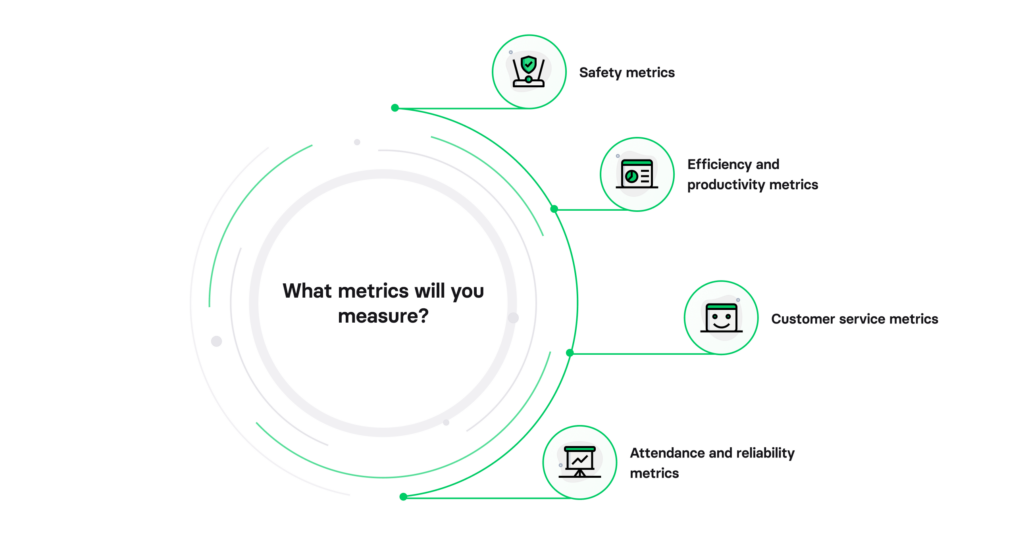
For a successful driver incentive program, selecting the right metrics to measure performance is crucial. These metrics should align with your company’s goals and provide a fair, objective basis for rewarding drivers. So, here are the metrics you can track:
1. Safety metrics
- Speeding incidents: Track occurrences of exceeding speed limits.
- Near misses: Monitor incidents that could have led to accidents.
- Use of safety equipment: Ensure compliance with safety protocols, like seatbelt usage.
- Driving record cleanliness: Evaluate the overall safety record of each driver.
- Roadside inspections: Regular checks for vehicle safety and compliance.
- Telematics data: Utilize data from devices to monitor routes and speed.
2. Efficiency and productivity metrics
- Fuel efficiency: Measure how effectively drivers are managing fuel consumption.
- Idling time: Track unnecessary idling to promote fuel efficiency and reduce wear on vehicles.
- Adherence to schedules: Monitor punctuality and schedule compliance.
- Cargo checks: Conduct random checks to ensure proper handling and transport of goods.
3. Customer service metrics
- Customer satisfaction: Collect feedback to assess the quality of service provided by drivers.
4. Attendance and reliability metrics
- Attendance records: Track the regularity and punctuality of drivers.
- Consistency in performance: Evaluate how consistently drivers meet or exceed standards.
The right metrics not only guide drivers toward desired behaviors but also contribute to the overall success of your fleet operations and maximizing your ROI.
How long will you track these metrics?
The tracking period can significantly impact the effectiveness of the program and the motivation of your drivers. Here’s how you can determine the optimal duration for tracking these metrics:
- Short-term goals: For immediate objectives, like safe driving habits or fuel efficiency improvements, a shorter tracking period, such as a month, can be effective. This allows for quick recognition and more immediate rewards, like certificates for a month of safe driving.
- Long-term goals: For objectives that require sustained effort, like long-term safety records or customer satisfaction improvements, consider a longer tracking period, such as quarterly or annually. This encourages consistent performance over time.
- Balancing goals: It’s beneficial to have a mix of short-term and long-term goals. This approach ensures that drivers are recognized for both immediate achievements and sustained efforts.
Driver incentive program template: an example of a driver reward program structure
By categorizing metrics, you can tailor your rewards program to encourage improvement in specific areas that align with your company’s goals. To customize this framework to suit your business needs, you can access and download this driver incentive program template in GoogleDoc format. And here is an example of a driver bonus program structure:
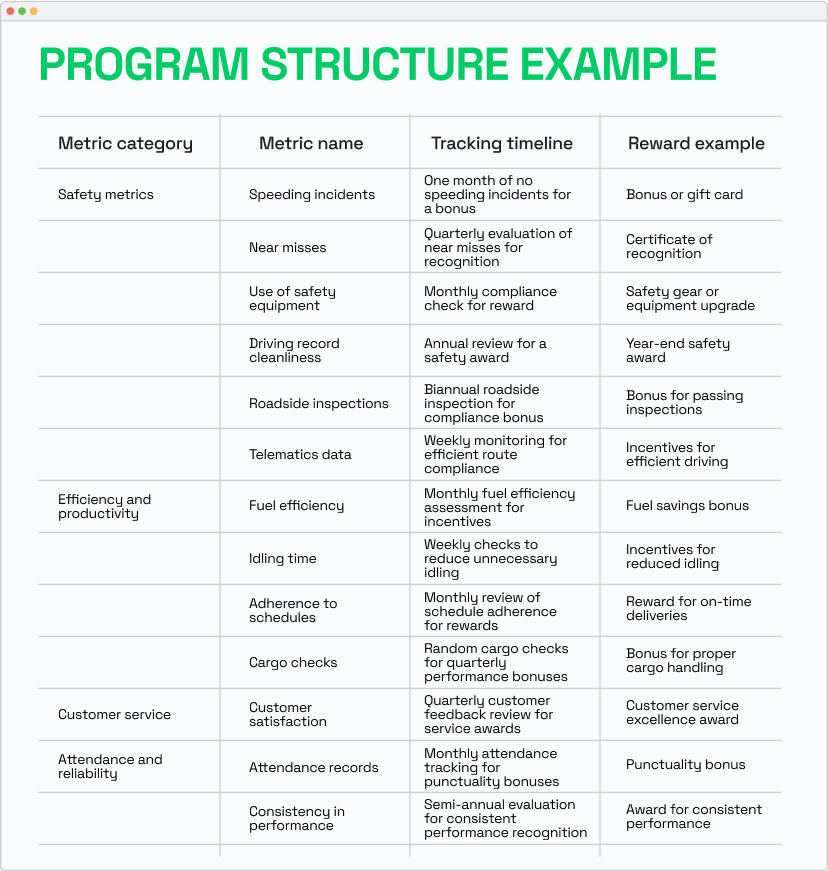
How to track your drivers’ performance: required tools and technology
Effectively measuring driver performance is a cornerstone of any successful truck driver bonus program. Tools such as fleet management software, GPS tracking devices, dash cams, and mobile apps can help you collect and analyze performance data, making the task of monitoring driver behavior both easier and more accurate.
Fleet management software
Fleet management software acts as a comprehensive tool for monitoring various aspects of driver performance. It offers insights into fuel usage, maintenance needs, and route efficiency. When choosing such software, look for one that integrates easily with other systems and provides a user-friendly interface for quick data collection and analysis.
GPS tracking devices
GPS tracking devices installed in vehicles are essential for real-time location monitoring and route efficiency analysis. These devices help ensure that drivers adhere to the most efficient routes and maintain optimal speeds. Regular updates and calibration are crucial for accurate tracking.
Dash cams
Dash cams offer visual records of driving practices and incidents. Opt for dash cams with both front-facing and driver-facing lenses to get a comprehensive view of both the road and the driver’s responses.
Mobile apps
Mobile apps are a convenient tool for drivers to report issues, track hours, and maintain communication. Select apps that are compatible with various smartphone models and offer an intuitive interface.
It’s crucial to choose the right technology that aligns with your business needs and goals. If you plan to develop a custom solution, consider checking out this comprehensive guide to fleet management software engineering, which can provide valuable insights into the latest trends and best practices.
How to get your fleet on board with a driver reward program
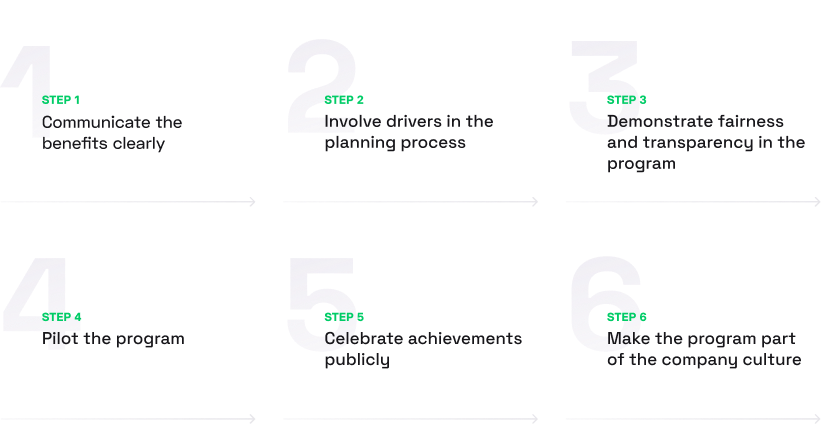
The success of a driver reward program hinges on how well it is received by your drivers. How can you ensure your fleet is fully on board with the program?
1. Communicate the benefits clearly
- Transparency: Begin by clearly communicating the goals and benefits of the reward program to your drivers. Explain how it can positively impact their work life, promote safe driving practices, and overall job satisfaction.
- Feedback sessions: Hold meetings or feedback sessions to discuss the program details, acknowledge drivers, and address suggestions from the drivers, especially concerning driver behaviors.
2. Involve drivers in the planning process
- Collaborative approach: Involve drivers in the planning stages. Their input can provide valuable insights into what rewards motivate drivers, particularly new drivers.
- Surveys and polls: Use surveys or polls to gauge drivers’ preferences and opinions about potential rewards and program structure, focusing on aspects like driver happiness and points system.
3. Demonstrate fairness and transparency in the program
- Clear criteria: Ensure the criteria for earning rewards are transparent and fair. This helps build trust in the program and makes drivers feel valued.
- Regular updates: Keep drivers informed about their progress and any changes in the program, which can help in reducing operating costs.
4. Pilot the program
- Trial run: Consider launching a pilot version of the program with a small group of drivers. This can help in identifying potential issues and making necessary adjustments before a full-scale roll-out.
- Pilot feedback: Gather feedback from the pilot participants to fine-tune the program, particularly focusing on incentivizing drivers.
5. Celebrate achievements publicly
- Recognition events: Host events or meetings where drivers are publicly awarded for their achievements, helping to further recognize drivers.
- Regular announcements: Make regular announcements celebrating the successes and milestones reached by drivers within the program, reinforcing driving safety.
6. Make the program part of the company culture
- Integration: Integrate the truck driver bonus program into your company’s culture. It should be seen as a key part of your organization’s commitment to valuing and respecting its drivers, particularly within trucking companies.
- Continuous promotion: Regularly promote the program’s successes and benefits within the company to maintain enthusiasm and participation.
The key is to ensure that the program is seen as a genuine effort to recognize and appreciate the hard work and dedication of your drivers. Through clear communication, involvement, and adaptation, you can create a program that not only improves morale and performance but also strengthens the bond between the company and its drivers.
What are the most common driver reward program mistakes?
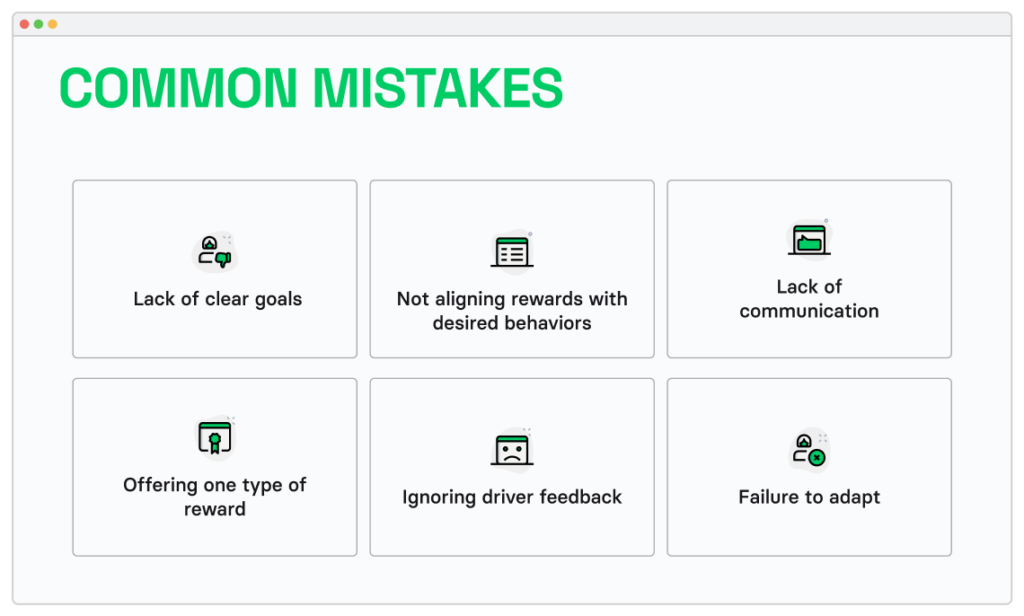
When implementing a driver reward program, it’s crucial to keep in mind certain pitfalls that can undermine its effectiveness:
Mistake 1: Lack of clear goals
Initiating a reward program without specific objectives can lead to confusion and lack of direction. It’s essential to define what you want to achieve, whether it’s reducing accidents, improving on-time deliveries, or enhancing customer satisfaction.
Mistake 2: Not aligning rewards with desired behaviors
Rewards that don’t align with the behaviors you want to encourage can send mixed messages. Ensure that the rewards directly reinforce the actions and outcomes you want to see from your drivers.
Mistake 3: Lack of communication
Failing to clearly communicate the details of the reward program can lead to misunderstandings and reduced participation. Consistent and transparent communication about how the program works and what drivers need to do to earn rewards is key.
Mistake 4: Offering one type of reward
Offering only one type of reward can limit the appeal of the program. Diverse rewards cater to different preferences and needs, making the program more inclusive and effective.
Mistake 5: Ignoring driver feedback
Not taking into account the opinions of drivers can lead to a disconnect between what the program offers and what drivers actually value. Regularly soliciting and incorporating driver feedback ensures the program remains relevant and appreciated.
Mistake 6: Failure to adapt
Not reviewing the program’s performance and making necessary adjustments can lead to stagnation and reduced effectiveness. It’s important to track the success of the program and be flexible in making changes based on performance data and driver feedback.
How to evaluate and improve your rewards and recognition program
A successful rewards and recognition program is not static; it requires ongoing evaluation and improvement to remain relevant. Here’s how you can assess and enhance your driver reward program:
Gather regular feedback
Collect input from drivers regarding the rewards program. This can be done through surveys, focus groups, or one-on-one interviews. Understanding their perspectives on what works and what doesn’t is crucial for making meaningful improvements.
Analyze program data
Review the data collected from the program. Look at metrics such as participation rates, the frequency of rewards given, and any correlations between the program and key performance indicators like accident rates, fuel efficiency, or customer satisfaction.
Assess the impact on company goals
Evaluate how well the program aligns with and supports broader company objectives. Determine if the rewards are effectively driving the desired behaviors and outcomes, such as improved safety records or increased productivity.
Solicit management feedback
Gather input from management and supervisors who interact directly with the drivers. Their observations can provide valuable insights into the effectiveness of the program and areas that might need adjustment.
Review and update the reward options
Regularly update the rewards offered to keep them appealing and relevant. This might involve introducing new types of rewards, adjusting the criteria for earning rewards or changing the recognition methods.
Communicate changes and updates
Any changes or improvements made to the program should be clearly communicated to all participants. Keeping drivers informed about updates not only maintains transparency but also re-engages them with the program.
Monitor long-term trends
Look at long-term trends in driver behavior and program engagement. This helps in understanding the sustained impact of the program and in identifying any gradual shifts that might require strategic changes.
By continuously evaluating and improving your reward program, you ensure that it remains effective, motivating, and aligned with both your drivers’ needs and your company’s objectives. This dynamic approach fosters a positive work culture and drives ongoing performance improvements.
How a driver reward program benefits your company

Adopting a driver reward program offers multifaceted benefits for your company, transcending the direct impact on your drivers. Here’s a breakdown of the positive outcomes such a program can generate for your organization:
Benefit 1: Enhanced road safety
By promoting and rewarding responsible driving habits, a safety incentive program can substantially lower the occurrence of accidents. This safety improvement not only benefits the drivers but also contributes to overall safer road conditions.
Benefit 2: Decreased insurance costs
Improved safety records can lead to lower insurance premiums, as insurers often offer better rates to businesses with fewer accidents and claims.
Benefit 3: Minimized operational expenditures
Rewarding drivers for efficient fuel usage and diligent vehicle maintenance can lead to significant reductions in operational costs. Proper vehicle care helps avoid costly repairs and extends vehicle longevity.
Benefit 4: Boosted productivity of drivers and fleet
Motivating drivers to meet performance goals can increase their efficiency. This enhanced productivity benefits both the drivers and the vehicles they operate, optimizing the overall fleet performance.
Benefit 5: Improved motivation and loyalty
Acknowledgment keeps drivers engaged, boosts their morale, and improves job satisfaction. Retaining skilled drivers reduces the costs and disruptions associated with the frequent hiring and training of new staff.
How Volpis can help you develop a custom software solution for your driver reward program (or incorporate new features)
Whether you’re looking to build a comprehensive software system from scratch or incorporate new features into an existing platform, Volpis is here to assist. Regularly ranked among the Top Custom Software Development Companies on Clutch.co, Volpis has been leveraging the power of technology to assist business owners in reaching unparalleled milestones.
Our team comprises over 35 in-house experts, bringing a wealth of experience and innovation to every project. We have designed and developed over 100 web and mobile applications worldwide, each tailored to meet the unique needs of our clients. Please check out our portfolio for a closer look at the innovative software systems we’ve developed for our clients.
If you have any questions about creating a driver reward program or building a custom software system for your business, please don’t hesitate to reach out to us via info@volpis.com to schedule a free, no-commitment consultation.
Questions & Answers
FAQ
How do I create a driver incentive program?
To create a driver incentive program, start by defining clear goals and objectives that align with your company’s needs. Then, select a range of rewards that will motivate and engage your drivers, ensuring you have the tools to measure their performance effectively.
How do you incentivize a truck driver?
For incentivizing drivers, offer a mix of rewards such as monetary bonuses, recognition awards, or personal development opportunities. These should be tailored to their preferences and your operational goals, which is a key strategy in the transportation industry to ensure drivers feel appreciated and that the company attracts and retains top talent.
What are some ways that you could incentivize better driving?
You can reward drivers (especially new drivers) by implementing a safety incentive program or offering safety bonuses for those who avoid accidents and meet fuel efficiency goals. This method encourages drivers to buy company apparel, highlighting their status as safe drivers and one of the best drivers in your fleet, which is among the biggest benefits for many fleets.
What are driver rewards?
Driver rewards are incentives provided for meeting or exceeding performance criteria, aimed at boosting morale and improving driver safety. This aspect of a safety incentive program plays a crucial role in how effectively drivers engage with their responsibilities and the overall success in driving operations.
Are safety incentive programs effective?
Safety incentive programs are effective, as they motivate drivers to adhere to strict safety standards, thereby reducing accidents. This is vital for managers who focus on promoting a culture of safety within the organization. Regular safety meetings help reinforce these standards across the own fleet, ensuring drivers receive immediate feedback on their performance. Such programs also address issues like cell phone use and encourage many drivers to commit to driving safely, further enhancing the overall safety culture.
What are the best types of incentives?
The best types of incentives are those that encourage drivers to consistently demonstrate safe driving habits and align with the company’s goals. Driver incentive programs may include monetary rewards, public recognition, safety incentive plan, professional development opportunities, and personalized incentives.






